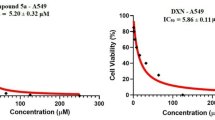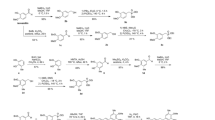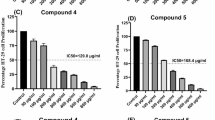Abstract
Aim:
To examine the antitumor effect of 4′-chloro-3,5-dihydroxystilbene, a resveratrol derivative, on lung adenocarcinoma A549 cells.
Methods:
The cytotoxic IC50 was determined by direct cell counting. Flow cytometry, monodansylcadaverine (MDC) staining, transfection, Western blot and a proteasome activity assay were used to study the cellular mechanism of 4′-chloro-3,5-dihydroxystilbene. A xenograft nude mouse model was used to analyze the antitumor effect in vivo.
Results:
4′-Chloro-3,5-dihydroxystilbene induced a rapid and persistent increase in the intracellular reactive oxygen species in the cells, but the cell death could not be inhibited by two antioxidant agents. The derivative caused sub-G1 formation, a decrease in the mitochondria membrane potential and poly (ADP-ribose) polymerase degradation, and the caspase inhibitor Z-VAD-FMK could partially prevent cell death. It also induced a significant increase in intracellular acidic vacuoles, LC3-II formation and intracellular GFP-LC3 aggregation. An autophagic inhibitor partially reversed cell death. Additionally, 4′-chloro-3,5-dihydroxystilbene induced the accumulation of ubiquitinated conjugates and inhibited proteasome activity in cells. In an in vivo study, 4′-chloro-3,5-dihydroxystilbene retarded tumor growth in nude mice.
Conclusion:
These data suggest that the resveratrol derivative 4′-chloro-3,5-dihydroxystilbene could be developed as an anti-tumor compound.
Similar content being viewed by others
Log in or create a free account to read this content
Gain free access to this article, as well as selected content from this journal and more on nature.com
or
References
Burns J, Yokota T, Ashihara H, Lean ME, Crozier A . Plant foods and herbal sources of resveratrol. J Agric Food Chem 2002; 50: 3337–40.
Hain R, Reif HJ, Krause E, Langebartels R, Kindl H, Vornam B, et al. Disease resistance results from foreign phytoalexin expression in a novel plant. Nature 1993; 361: 153–6.
Pace-Asciak CR, Hahn S, Diamandis EP, Soleas G, Goldberg DM . The red wine phenolics trans-resveratrol and quercetin block human platelet aggregation and eicosanoid synthesis: implications for protection against coronary heart disease. Clin Chim Acta 1995; 235: 207–19.
Djoko B, Chiou RY, Shee JJ, Liu YW . Characterization of immunological activities of peanut stilbenoids, arachidin-1, piceatannol, and resveratrol on lipopolysaccharide-induced inflammation of RAW 264.7 macrophages. J Agric Food Chem 2007; 55: 2376–83.
Belguendouz L, Fremont L, Linard A . Resveratrol inhibits metal ion-dependent and independent peroxidation of porcine low-density lipoproteins. Biochem Pharmacol 1997; 53: 1347–55.
Jang M, Cai L, Udeani GO, Slowing KV, Thomas CF, Beecher CW, et al. Cancer chemopreventive activity of resveratrol, a natural product derived from grapes. Science 1997; 275: 218–20.
Aggarwal BB, Bhardwaj A, Aggarwal RS, Seeram NP, Shishodia S, Takada Y . Role of resveratrol in prevention and therapy of cancer: preclinical and clinical studies. Anticancer Res 2004; 24: 2783–840.
Kundu JK, Surh YJ . Cancer chemopreventive and therapeutic potential of resveratrol: mechanistic perspectives. Cancer Lett 2008; 269: 243–61.
Sale S, Verschoyle RD, Boocock D, Jones DJ, Wilsher N, Ruparelia KC, et al. Pharmacokinetics in mice and growth-inhibitory properties of the putative cancer chemopreventive agent resveratrol and the synthetic analogue trans 3,4,5,4′-tetramethoxystilbene. Br J Cancer 2004; 90: 736–44.
Jemal A, Siegel R, Ward E, Hao Y, Xu J, Murray T, et al. Cancer statistics, 2008. CA Cancer J Clin 2008; 58: 71–96.
Chen LG, Hung LY, Tsai KW, Pan YS, Tsai YD, Li YZ, et al. Wogonin, a bioactive flavonoid in herbal tea, inhibits inflammatory cyclooxygenase-2 gene expression in human lung epithelial cancer cells. Mol Nutr Food Res 2008; 52: 1349–57.
Kabeya Y, Mizushima N, Ueno T, Yamamoto A, Kirisako T, Noda T, et al. LC3, a mammalian homologue of yeast Apg8p, is localized in autophagosome membranes after processing. Embo J 2000; 19: 5720–8.
Alexandre J, Batteux F, Nicco C, Chereau C, Laurent A, Guillevin L, et al. Accumulation of hydrogen peroxide is an early and crucial step for paclitaxel-induced cancer cell death both in vitro and in vivo. Int J Cancer 2006; 119: 41–8.
Sharpe JC, Arnoult D, Youle RJ . Control of mitochondrial permeability by Bcl-2 family members. Biochim Biophys Acta 2004; 1644: 107–13.
Okada H, Mak TW . Pathways of apoptotic and non-apoptotic death in tumour cells. Nat Rev Cancer 2004; 4: 592–603.
Mizushima N, Yamamoto A, Hatano M, Kobayashi Y, Kabeya Y, Suzuki K, et al. Dissection of autophagosome formation using Apg5-deficient mouse embryonic stem cells. J Cell Biol 2001; 152: 657–68.
Mizushima N, Yamamoto A, Matsui M, Yoshimori T, Ohsumi Y . In vivo analysis of autophagy in response to nutrient starvation using transgenic mice expressing a fluorescent autophagosome marker. Mol Biol Cell 2004; 15: 1101–11.
Kondo Y, Kanzawa T, Sawaya R, Kondo S . The role of autophagy in cancer development and response to therapy. Nat Rev Cancer 2005; 5: 726–34.
Kroemer G, Jaattela M . Lysosomes and autophagy in cell death control. Nat Rev Cancer 2005; 5: 886–97.
O'Sullivan MP, O'Leary S, Kelly DM, Keane J. A caspase-independent pathway mediates macrophage cell death in response to Mycobacterium tuberculosis infection. Infect Immun 2007; 75: 1984–93.
Kim YA, Lee WH, Choi TH, Rhee SH, Park KY, Choi YH . Involvement of p21WAF1/CIP1, pRB, Bax and NF-kappaB in induction of growth arrest and apoptosis by resveratrol in human lung carcinoma A549 cells. Int J Oncol 2003; 23: 1143–9.
Schneider Y, Vincent F, Duranton B, Badolo L, Gosse F, Bergmann C, et al. Anti-proliferative effect of resveratrol, a natural component of grapes and wine, on human colonic cancer cells. Cancer Lett 2000; 158: 85–91.
Joe AK, Liu H, Suzui M, Vural ME, Xiao D, Weinstein IB . Resveratrol induces growth inhibition, S-phase arrest, apoptosis, and changes in biomarker expression in several human cancer cell lines. Clin Cancer Res 2002; 8: 893–903.
Bernhard D, Tinhofer I, Tonko M, Hubl H, Ausserlechner MJ, Greil R, et al. Resveratrol causes arrest in the S-phase prior to Fas-independent apoptosis in CEM-C7H2 acute leukemia cells. Cell Death Differ 2000; 7: 834–42.
Pelicano H, Carney D, Huang P . ROS stress in cancer cells and therapeutic implications. Drug Resist Updat 2004; 7: 97–110.
Valko M, Rhodes CJ, Moncol J, Izakovic M, Mazur M . Free radicals, metals and antioxidants in oxidative stress-induced cancer. Chem Biol Interact 2006; 160: 1–40.
Ly JD, Grubb DR, Lawen A . The mitochondrial membrane potential (deltapsi(m)) in apoptosis; an update. Apoptosis 2003; 8: 115–28.
Tinhofer I, Bernhard D, Senfter M, Anether G, Loeffler M, Kroemer G, et al. Resveratrol, a tumor-suppressive compound from grapes, induces apoptosis via a novel mitochondrial pathway controlled by Bcl-2. Faseb J 2001; 15: 1613–5.
Malanga M, Althaus FR . The role of poly(ADP-ribose) in the DNA damage signaling network. Biochem Cell Biol 2005; 83: 354–64.
Bursch W, Ellinger A, Kienzl H, Torok L, Pandey S, Sikorska M, et al. Active cell death induced by the anti-estrogens tamoxifen and ICI 164 384 in human mammary carcinoma cells (MCF-7) in culture: the role of autophagy. Carcinogenesis 1996; 17: 1595–607.
Shao Y, Gao Z, Marks PA, Jiang X . Apoptotic and autophagic cell death induced by histone deacetylase inhibitors. Proc Natl Acad Sci USA 2004; 101: 18030–5.
Takeuchi H, Kondo Y, Fujiwara K, Kanzawa T, Aoki H, Mills GB, et al. Synergistic augmentation of rapamycin-induced autophagy in malignant glioma cells by phosphatidylinositol 3-kinase/protein kinase B inhibitors. Cancer Res 2005; 65: 3336–46.
Opipari AW Jr, Tan L, Boitano AE, Sorenson DR, Aurora A, Liu JR . Resveratrol-induced autophagocytosis in ovarian cancer cells. Cancer Res 2004; 64: 696–703.
Gills JJ, Lopiccolo J, Tsurutani J, Shoemaker RH, Best CJ, Abu-Asab MS, et al. Nelfinavir, a lead HIV protease inhibitor, is a broad-spectrum, anticancer agent that induces endoplasmic reticulum stress, autophagy, and apoptosis in vitro and in vivo. Clin Cancer Res 2007; 13: 5183–94.
Bazzaro M, Lee MK, Zoso A, Stirling WL, Santillan A, Shih Ie M, et al. Ubiquitin-proteasome system stress sensitizes ovarian cancer to proteasome inhibitor-induced apoptosis. Cancer Res 2006; 66: 3754–63.
Kisselev AF, Callard A, Goldberg AL . Importance of the different proteolytic sites of the proteasome and the efficacy of inhibitors varies with the protein substrate. J Biol Chem 2006; 281: 8582–90.
Acknowledgements
This work was supported by grants from the National Science Council of Taiwan (NSC97-2320-B-415-002) and the Buddhist Tzuchi Dalin General Hospital (DTCRD97(2)-08).
Author information
Authors and Affiliations
Corresponding author
Supplementary information
Supplementary information
The structure and cytotoxicity of resveratrol derivaties. (JPG 67 kb)
Rights and permissions
About this article
Cite this article
Wu, Jy., Tsai, Kw., Shee, Jj. et al. 4′-Chloro-3,5-dihydroxystilbene, a resveratrol derivative, induces lung cancer cell death. Acta Pharmacol Sin 31, 81–92 (2010). https://doi.org/10.1038/aps.2009.182
Received:
Accepted:
Published:
Issue date:
DOI: https://doi.org/10.1038/aps.2009.182



